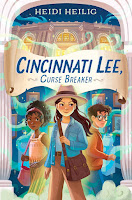

at
Strengths: A large number of middle school boys really believe that they can grow up to play professional basketball, so this will have an immediate draw! There aren't quite as many who want to pursue theater, but the two activities got tied together in a very clever way. I enjoyed the fact that the boys didn't just give up when they didn't get to work on their skills in a school setting. This is a great message, since there are plenty of kids who don't make sports teams or get cast in school productions. This was from multiple points of view, and Miley's chapters included some illustrations and had lettered text that discussed her challenges in making friends and her discussions with her therapist. I also really liked how both Martina and Charlotte were welcomed onto the team without comment, and how they were able to stand up to the Hawks when they trash talked them. As I tell the boys' cross country team just about every year: if you want to win the district championship, you need to run like girls! This moved quickly, and the cover will appeal to basketball fans.
Weaknesses: The story would have progressed more smoothly with a third person omniscient narrator; I know authors love to write from different perspectives, but it does make the story jump around. Also, 6th graders in Ohio can't be on sports teams with older students, and I doubt that the coach would be able to put Jax and Nic on the varsity team because they won a bet with him.
What I really think: This is a good choice for readers who like to combine sports topics with the performing arts and enjoyed Friday Nigth Stage Lights or Mided's Club Kick Out. Brown and Morris are also the authors of Squint.
Lady of the Lines: How Maria Reiche Saved the Nazca Lines by Sweeping the Desert
April 8, 2025 by Astra Young Readers
Copy provided by the publisher
I love reading books that introduce me to things I've never heard of, and Maria Reiche's involvement with saving the Nazca Lines artwork in the Peruvian desert was completely new to me. German born Reiche took a job as a nanny in Peru, and became so invested in this ancient artwork that she spent the rest of her life working on saving it. These massive drawings, Etched into the desert floor, where preserved because of the dry climate and lack of traffic in the area, but centuries of dirt and dust had dimmed their beauty. Reiche set out with actual brooms to sweep away the dirt and reveal the drawings. Working in the 1940s meant that she labored until harsh conditions, living in tents with few amenities and subsisting on a meager diet. While she was successful in uncovering the art, the work took a toll on her health. In addition to preserving the art, she worked hard to have the work protected by the government, so that it would be safe from development as well as uncaring tourists. She wrote books about the art, and managed to call attention to it so that the area was designated a UNESCO world heritage site in 1994. The book includes notes on Reiche's life and work, a timeline, and a bibliography.
The illustrations for a good job of capturing a sense of place and time; one especially appealing spread shows Reiche, in a dress and kerchief, loading brooms onto the top of a Volkswagen Beatle, opposite a picture of her alone in the middle of the vast desert, sweeping the dirt away from the lines while wearing padded flip flops. There is a lot of yellow and bright blue, giving a sense of heat and brightness that brings the desert environment alive.
While this isn't too long for a read aloud, there is plenty of information to get young readers started on a research project into this interesting champion of a archaeological and artistic phenomenon that will be new to many readers in the US.
Reiche's story combines art, archaeology, and activism, and is right at home with books like Rogers and Innerst's Joan Mitchell Paints a Symphony, Novesky and Lee's Mary Blair's Unique Flair: The Girl Who Became One of the Disney Legends, Whitehead and Evans' Art From Her Heart: Folk Artist Clementine Hunter, Brown and Sicuro's Dancing Through Fields of Color (Helen Frankenthaler), and also Skeers and Miguens' Dinosaur Lady: The Daring Discoveries of Mary Anning, the First Paleontologist.

.jpg)











































